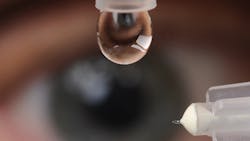Microneedles Accurately Deliver Drugs to the Eye
Biomedical researchers at the Georgia Institute of Technology have devised two new applications for using microneedles 400 to 700 microns long to help fight eye diseases. The small needles let doctors target the drug to specific areas of the eye, which should increase the drug’s effectiveness while limiting side effects and using less of the expensive drugs.
In one application, a painless injection with a microneedle done every three to six months can replace daily administration of eye drops to stave off glaucoma. It is the second leading cause of blindness and affects about 2.2 million people in the U.S. It is hoped the injections will provide more consistent dosages and make it easier on patients who sometimes neglect to apply eye drops daily. The drug is formulated to be relatively viscous, letting it stay where it is injected. In animal studies, researchers could reduce intraocular pressure, the major symptom, using just 1% of the amount of drug used with eye drops.
In the second application, a solid needle places precise amounts of a dry drug on the injured area of the cornea. The needles are held in place for about a minute as the drug is absorbed. The antibody–based drug inhibits growth of new blood vessels, a problem with neovascularization in which unwanted blood vessels impair vision.
Although eye injections with hypodermic needles much larger than microneedles routinely administer compounds into the center of eye, those needles are not designed for eye injections and are not the best for delivering drugs to various parts of the eye. And eye drops are often unable to get the drugs where they need to go. Microneedles, however, can be tailored to penetrate the eye only as far as needed. For the glaucoma drug, for instance, the needle is only about half a millimeter long, which is enough to penetrate through the sclera and outer layer of the eye to where it needs to be, the supraciliary space.

